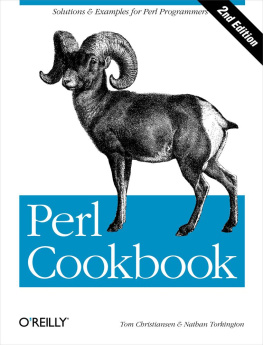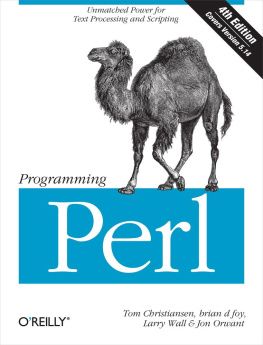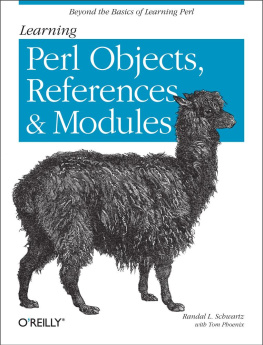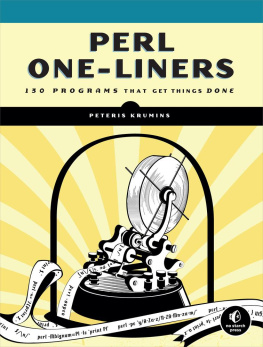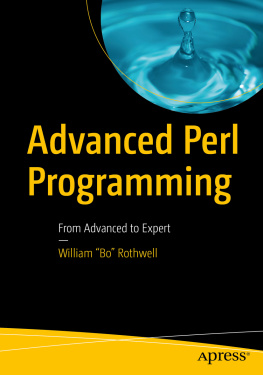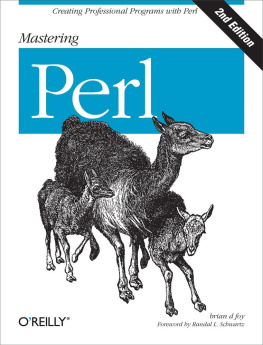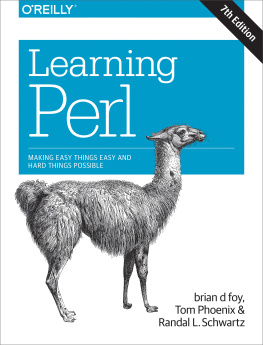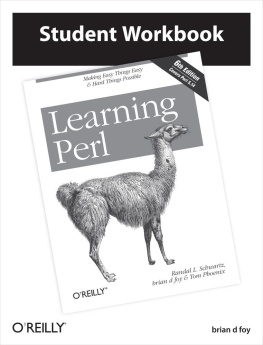Supplemental files and examples for this book can be found at http://examples.oreilly.com/9780596003135/. Please use a standard desktop web browser to access these files, as they may not be accessible from all ereader devices.
All code files or examples referenced in the book will be available online. For physical books that ship with an accompanying disc, whenever possible, weve posted all CD/DVD content. Note that while we provide as much of the media content as we are able via free download, we are sometimes limited by licensing restrictions. Please direct any questions or concerns to .
Foreword
They say that it's easy to get trapped by a metaphor. But some metaphors are so magnificent that you don't mind getting trapped in them. Perhaps the cooking metaphor is one such, at least in this case. The only problem I have with it is a personal oneI feel a bit like Betty Crocker's mother. The work in question is so monumental that anything I could say here would be either redundant or irrelevant.
However, that never stopped me before.
Cooking is perhaps the humblest of the arts; but to me humility is a strength, not a weakness. Great artists have always had to serve their artistic mediumgreat cooks just do so literally. And the more humble the medium, the more humble the artist must be in order to lift the medium beyond the mundane. Food and language are both humble media, consisting as they do of an overwhelming profusion of seemingly unrelated and unruly ingredients. And yet, in the hands of someone with a bit of creativity and discipline, things like potatoes, pasta, and Perl are the basis of works of art that "hit the spot" in a most satisfying way, not merely getting the job done, but doing so in a way that makes your journey through life a little more pleasant.
Cooking is also one of the oldest of the arts. Some modern artists would have you believe that so-called ephemeral art is a recent invention, but cooking has always been an ephemeral art. We can try to preserve our art, make it last a little longer, but even the food we bury with our pharoahs gets dug up eventually. So too, much of our Perl programming is ephemeral. This aspect of Perl cuisine has been much maligned. You can call it quick-and-dirty if you like, but there are billions of dollars out there riding on the supposition that fast food is not necessarily dirty food. (We hope.)
Easy things should be easy, and hard things should be possible. For every fast-food recipe, there are countless slow-food recipes. One of the advantages of living in California is that I have ready access to almost every national cuisine ever invented. But even within a given culture, There's More Than One Way To Do It. It's said in Russia that there are more recipes for borscht than there are cooks, and I believe it. My mom's recipe doesn't even have any beets in it! But that's okay, and it's more than okay. Borscht is a cultural differentiator, and different cultures are interesting, and educational, and useful, and exciting.
So you won't always find Tom and Nat doing things in this book the way I would do them. Sometimes they don't even do things the same way as each other. That's okayagain, this is a strength, not a weakness. I have to confess that I learned quite a few things I didn't know before I read this book. What's more, I'm quite confident that I still don't know it all. And I hope I don't any time soon. I often talk about Perl culture as if it were a single, static entity, but there are in fact many healthy Perl subcultures, not to mention sub-subcultures and supercultures and circumcultures in every conceivable combination, all inheriting attributes and methods from each other. It can get confusing. Hey, I'm confused most of the time.
So the essence of a cookbook like this is not to cook for you (it can't), or even to teach you how to cook (though it helps), but rather to pass on various bits of culture that have been found useful, and perhaps to filter out other bits of "culture" that grew in the refrigerator when no one was looking. You in turn will pass on some of these ideas to other people, filtering them through your own experiences and tastes, your creativity and discipline. You'll come up with your own recipes to pass to your children. Just don't be surprised when they in turn cook up some recipes of their own, and ask you what you think. Try not to make a face.
I commend to you these recipes, over which I've made very few faces.
Larry Wall, June, 1998
Preface
The investment group eyed the entrepreneur with caution, their expressions flickering from scepticism to intrigue and back again.
"Your bold plan holds promise," their spokesman conceded. "But it is costly and entirely speculative. Our mathematicians mistrust your figures. Why should we entrust our money into your hands? What do you know that we do not?"
"For one thing," he replied, "I know how to balance an egg on its point without outside support. Do you?" And with that, the entrepreneur reached into his satchel and delicately withdrew a fresh hen's egg. He handed over the egg to the financial tycoons, who passed it amongst themselves trying to carry out the simple task. At last they gave up. In exasperation they declared, "What you ask is impossible! No man can balance an egg on its point."
So the entrepreneur took back the egg from the annoyed businessmen and placed it upon the fine oak table, holding it so that its point faced down. Lightly but firmly, he pushed down on the egg with just enough force to crush in its bottom about half an inch. When he took his hand away, the egg stood there on its own, somewhat messy, but definitely balanced. "Was that impossible?" he asked.
"It's just a trick," cried the businessmen. "Once you know how, anyone can do it."
"True enough," came the retort. "But the same can be said for anything. Before you know how, it seems an impossibility. Once the way is revealed, it's so simple that you wonder why you never thought of it that way before. Let me show you that easy way, so others may easily follow. Will you trust me?"
Eventually convinced that this entrepreneur might possibly have something to show them, the skeptical venture capitalists funded his project. From the tiny Andalusian port of Palos de Moguer set forth the Nia , the Pinta , and the Santa Mara , led by an entrepreneur with a slightly broken egg and his own ideas: Christopher Columbus.
Many have since followed.
Approaching a programming problem can be like balancing Columbus's egg. If no one shows you how, you may sit forever perplexed, watching the eggand your programfall over again and again, no closer to the Indies than when you began. This is especially true in a language as idiomatic as Perl.


